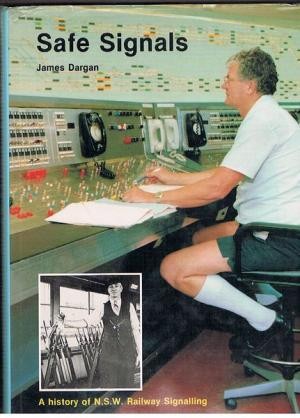pp. 225 illusts #0617 Australia Railways
- Railroads — New South Wales — Signaling — History.
-
Railway signals in New South Wales broadly follow British route signaling practice, with certain American influences and local innovations. The following systems are currently in use, listed in chronological order of introduction: two-position lower quadrant semaphore, three-position upper quadrant semaphore, Double Light Colour Light and Single Light Colour Light.
Double Light signals are capable of showing more indications than Single Light signals, therefore Double Light signals are more appropriate for use in dense traffic areas, such as the Sydney metropolitan area, and Single Light signals for the less intense areas. However combinations of the different types may be found at the same interlocking locations.
Systems of train signalling
New South Wales signalling systems generally follow British precepts, however American influence has increased somewhat since the 1990s. Originally trains ran on the time-interval system and authority of the timetable. From the early 1870s, several near-misses and minor derailments led to serious discussion of improved safe-working arrangements and the implementation of interlocking. Despite this, very little action was taken until 1877, when a new rule book including the Staff & Ticket and Block Telegraph systems was finally printed. The ink was barely dry on 30 January 1878 when two trains collided head-on at Emu Plains, killing three. This put an end to timetable working on single lines. Absolute Block Telegraph for double lines came in 1879, Saxby & Farmer’s mechanical interlocking in 1881, Tyer’s Electric Tablet in 1888 (lasting until 1959) and the Electric Staff system in 1891. Tyer’s One-Wire Block began to replace the original Preece’s Patent instruments from 1891. Sykes’ Lock & Block was used on a few suburban sections from 1900. Tyer’s Three-Wire Block was used for permissive block working on the Up Relief line from Concord West to North Strathfield Junction from 1911 until 1983. In 1913, the two-wire New South Wales Standard Block, which was similar in principle to Lock & Block, became the standard for new installations. It was unique in having a fourth position, known as Train Arrived, and a different sequence of operation to standard British arrangements. The last of these instruments were removed from Exeter, Bundanoon and Wingello on the Main South line in 2007. By 1907, the majority of signalling equipment, including signals and mechanical lever frames, were being manufactured in-house under the direction of the English-born signal engineer, Mr C.L.N.F. Wilkin. The NSWR Signal Engineer’s Branch supplanted McKenzie & Holland as the principal supplier in most installations.
